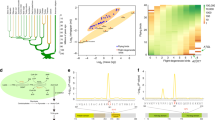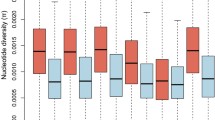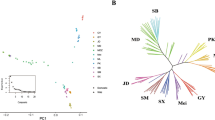Abstract
The genetic and molecular mechanisms of the flightless birds without limb modification are rarely reported. To explore the possible reasons for losing flight ability without limb modification, we used the domestic geese as an ideal model to preliminarily study the possible mechanisms for this kind of flightlessness. We compared the sequence variations of the exon 10 of TSHR gene between three domesticated geese populations and two wild ancestor populations. The results showed that domestic geese had higher genetic diversity and more complex population structure than their wild ancestors. We did not detect any population expansion in domestic geese population. However, we detected clear relaxed selection signal and positive selection in domesticated geese groups. Furthermore, special phylogenetic relationship of the exon 10 of TSHR was observed in domesticated geese groups. Combined with its well-established function on metabolic regulation and photoperiod control, we speculate that relaxed selection of TSHR might have effects on flightlessness of domesticated geese.





Similar content being viewed by others
References
Burga A, Wang W et al (2017) A genetic signature of the evolution of loss of flight in the Galapagos cormorant. Science 356(6341):eaal3345
Carter GR, Scott-Moncrieff JC et al (2009) Serum total thyroxine and thyroid stimulating hormone concentrations in dogs with behavior problems. J Vet Behav Clin Appl Res 4(6):230–236
Darwin C, Bynum WF (2009) The origin of species by means of natural selection: or, the preservation of favored races in the struggle for life. AL Burt
De GB, Grommen SV et al (2013) Hatching the cleidoic egg: the role of thyroid hormones. Front Endocrinol 4:63
Deelman E, Singh G et al (2005) Pegasus: a framework for mapping complex scientific workflows onto distributed systems. Sci Program 13(3):219–237
Ericson PGP, Tyrberg T (2004) The early history of the Swedish avifauna. A review of the subfossil record and early written sources
Hall TA (1999) BioEdit: a user-friendly biological sequence alignment editor and analysis program for Windows 95/98/NT. Nucl Acids Symp Ser
Hanon EA, Lincoln GA et al (2008) Ancestral TSH mechanism signals summer in a photoperiodic mammal. Curr Biol 18(15):1147–1152
Huelsenbeck JP, Ronquist F (2001) MRBAYES: Bayesian inference of phylogenetic trees. Bioinformatics 17(8):754–755
Kennedy M, Valle CA et al (2009) The phylogenetic position of the Galápagos Cormorant. Mol Phylogenet Evol 53(1):94–98
Kumar S, Stecher G et al (2016) “MEGA7: molecular evolutionary genetics analysis version 7.0 for bigger datasets. Mol Biol Evol 33(7):1870
Librado P, Rozas J (2009) DnaSP v5: a software for comprehensive analysis of DNA polymorphism data. Bioinformatics 25(11):1451–1452
Mannermaa K (2014) Goose: domestication. Springer, New York
McMurdie PJ, Holmes S (2013) phyloseq: an R package for reproducible interactive analysis and graphics of microbiome census data. PloS One 8(4):e61217
Mitchell KJ, Llamas B et al (2014) Ancient DNA reveals elephant birds and kiwi are sister taxa and clarifies ratite bird evolution. Science 344(6186):898–900
Nakao N, Ono H et al (2008) Thyrotrophin in the pars tuberalis triggers photoperiodic response. Nature 452(7185):317
Pond SLK, Frost SD (2005) Datamonkey: rapid detection of selective pressure on individual sites of codon alignments. Bioinformatics 21(10):2531–2533
Pritchard JK, Stephens M et al (2000) Inference of population structure using multilocus genotype data. Genetics 155(2):945–959
Roff DA (1994) The evolution of flightlessness: is history important?. Evol Ecol 8(6):639–657
Rubin CJ, Zody MC et al (2010) Whole-genome resequencing reveals loci under selection during chicken domestication. Nature 464(7288):587
Shen Y-Y, Shi P et al (2009) Relaxation of selective constraints on avian mitochondrial DNA following the degeneration of flight ability. Genome Res 19(10):1760–1765
Shi XW, Wang JW et al (2006) Mitochondrial DNA cleavage patterns distinguish independent origin of Chinese domestic geese and western domestic geese. Biochem Genet 44(5–6):237–245
Slack KE, Jones CM et al (2006) Early penguin fossils, plus mitochondrial genomes, calibrate avian evolution. Mol Biol Evol 23(6):1144–1155
Thompson JD, Gibson TJ et al (1997) The ClustalX windows interface: flexible strategies for multiple sequence alignment aided by quality analysis tools. Nucleic Acids Res 25(25):4876–4882
Wickham H (2009) plyr: Tools for splitting, applying and combining data. R package version 0(1 9):651
Acknowledgements
This work was funded by the National Natural Science Foundation of China (Nos. 31172181 and 31660663) and the National Waterfowl Industrial Technology System (Nos. CARS-43-4 and 2016YFD0500510).
Author information
Authors and Affiliations
Corresponding author
Ethics declarations
Conflict of interest
The authors declare that they have no competing interests.
Electronic supplementary material
Below is the link to the electronic supplementary material.
Rights and permissions
About this article
Cite this article
Peng, Q., Wang, Y., Hu, Y. et al. High sequence variation in the exon 10 of TSHR gene is associated with flightless-domestic geese. 3 Biotech 8, 353 (2018). https://doi.org/10.1007/s13205-018-1371-3
Received:
Accepted:
Published:
DOI: https://doi.org/10.1007/s13205-018-1371-3




